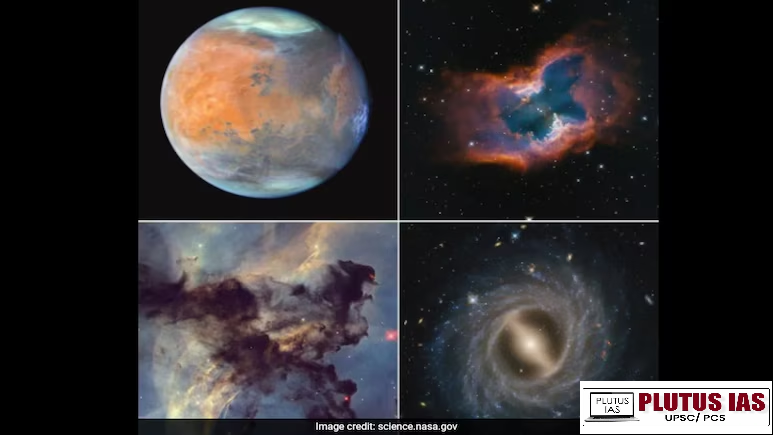25 Apr Hubble Space Telescope: 35 Years of Cosmic Discovery
This article covers “Daily Current Affairs” and the Topic of the Hubble Space Telescope: 35 Years of Cosmic Discovery.
SYLLABUS MAPPING:
GS-3-Science and technology-Hubble Space Telescope: 35 Years of Cosmic Discovery
FOR PRELIMS
What is the Hubble Space Telescope? What is the role of the Hubble Space Telescope in studying black holes and their impact on galaxies?
FOR MAINS
What are the key features of the Hubble Space Telescope, and what challenges did the Hubble Space Telescope face during its operational life?
Why in the News?
In celebration of the NASA/ESA Hubble Space Telescope’s 35 years in Earth orbit, a stunning collection of recent images captured by Hubble has been released. These images showcase a range of celestial phenomena, from detailed views of Mars to striking depictions of stellar birth and death, as well as a magnificent neighbouring galaxy. Hubble’s continued success and relevance in space exploration highlight its significant contributions to our understanding of the universe over the past three decades. As one of the most iconic scientific instruments in history, Hubble’s imagery continues to inspire and shape our perception of the cosmos. The release of these images marks a milestone in the telescope’s legacy, reaffirming its position as a cornerstone of modern astronomical research.

Hubble Telescope
The Hubble Space Telescope (HST) is one of the most iconic and influential instruments in the history of astronomy. Launched on April 24, 1990, by NASA aboard the Space Shuttle Discovery (STS-31 mission), it has provided humanity with breathtaking views of space and profound insights into the universe. The Hubble Space Telescope is named after Edwin Hubble, the American astronomer whose work helped establish the concept of an expanding universe.
Key features of the Hubble telescope
| Feature | Details |
|---|---|
| 1. Large Primary Mirror | Size: 2.4 meters (7.9 feet) – Allows Hubble to capture high-resolution images of distant objects. |
| 2. Wide Range of Observations | Observes in UV, visible, and near-infrared wavelengths, enabling it to study various cosmic phenomena. |
| 3. Orbit Above Earth’s Atmosphere | Altitude: 547 kilometres (340 miles) – Avoids atmospheric distortion, providing clearer images than ground-based telescopes. |
| 4. High-Resolution Imaging | Achieves a resolution of 0.05 arcseconds, offering incredibly sharp images of distant objects. |
| 5. Significant Discoveries | Helped determine the expansion rate of the universe and contributed to the discovery of dark energy and refined the age of the universe to 13.8 billion years. |
| 6. The Hubble Deep Field | Captured in 1995, revealed thousands of galaxies in a small patch of sky, providing insight into the early universe. |
| 7. Serviceable in Space | Designed to be serviced and upgraded by astronauts. Five servicing missions between 1993 and 2009 were conducted to install new instruments and fix issues. |
| 8. Data Contributions to Science | 1.4 million observations and 15,000 scientific papers published based on Hubble’s data, influencing various fields of astrophysics. |
| 9. Lifetime and Legacy | Operational for over 30 years, expected to continue until 2030-2040, maintaining its importance despite the launch of new telescopes like James Webb. |
Achievements of the Hubble Space Telescope
1. Expansion Rate of the Universe: Hubble’s observations helped measure the Hubble Constant, refining the expansion rate of the universe. The current value is about 73.3 km/s/Mpc, which is crucial for understanding cosmology.
2. Discovery of Dark Energy: In 1998, Hubble’s data helped reveal the existence of dark energy, which accounts for around 68% of the universe, by observing the accelerating expansion of the universe.
3. Determining the Age of the Universe: By studying Cepheid variable stars, Hubble contributed to refining the age of the universe, now calculated to be approximately 13.8 billion years.
4. Hubble Deep Field (HDF): In 1995, Hubble captured the iconic Hubble Deep Field image, revealing thousands of galaxies in a small patch of the sky. This image allowed astronomers to peer back into the 13 billion-year history of the universe.
5. Black Hole Imaging: In 2006, Hubble helped confirm the presence of supermassive black holes at the centres of galaxies, including our own Milky Way, which hosts a 4 million solar mass black hole.
6. Discovery of Exoplanets: Hubble played a significant role in identifying and studying hundreds of exoplanets, contributing to our understanding of planetary atmospheres. Some of these exoplanets have shown signs of water vapour.
7. Tracking the Impact of Comet Shoemaker-Levy 9: In 1994, Hubble provided real-time images of Comet Shoemaker-Levy 9’s dramatic collision with Jupiter, giving scientists valuable insights into the effects of planetary impact events.
8. Stellar and Planetary Birth and Death: Hubble captured breathtaking images of stellar nurseries (such as the Eagle Nebula) and supernova remnants, advancing our understanding of stellar life cycles, from birth to death.
Conclusion
The Hubble Space Telescope has significantly shaped our understanding of the universe over the past 35 years, producing ground-breaking discoveries and iconic imagery. Despite the advent of newer technologies, its legacy continues to inspire and influence the field of astronomy, underscoring its indispensable role in the exploration of space. Hubble has not only expanded our knowledge of distant galaxies but also paved the way for future space missions, such as the James Webb Space Telescope. As we celebrate its accomplishments, Hubble remains a testament to human ingenuity and the quest to explore the cosmos. Its invaluable contributions will continue to fuel astronomical research for years to come.
Download Plutus IAS Current Affairs (Eng) 25th April 2025
Prelims Questions
Q. Describe the Hubble Space Telescope’s design and operational features that allow it to capture high-resolution images and contribute to major scientific discoveries.?
(250 words, 15 marks)




No Comments